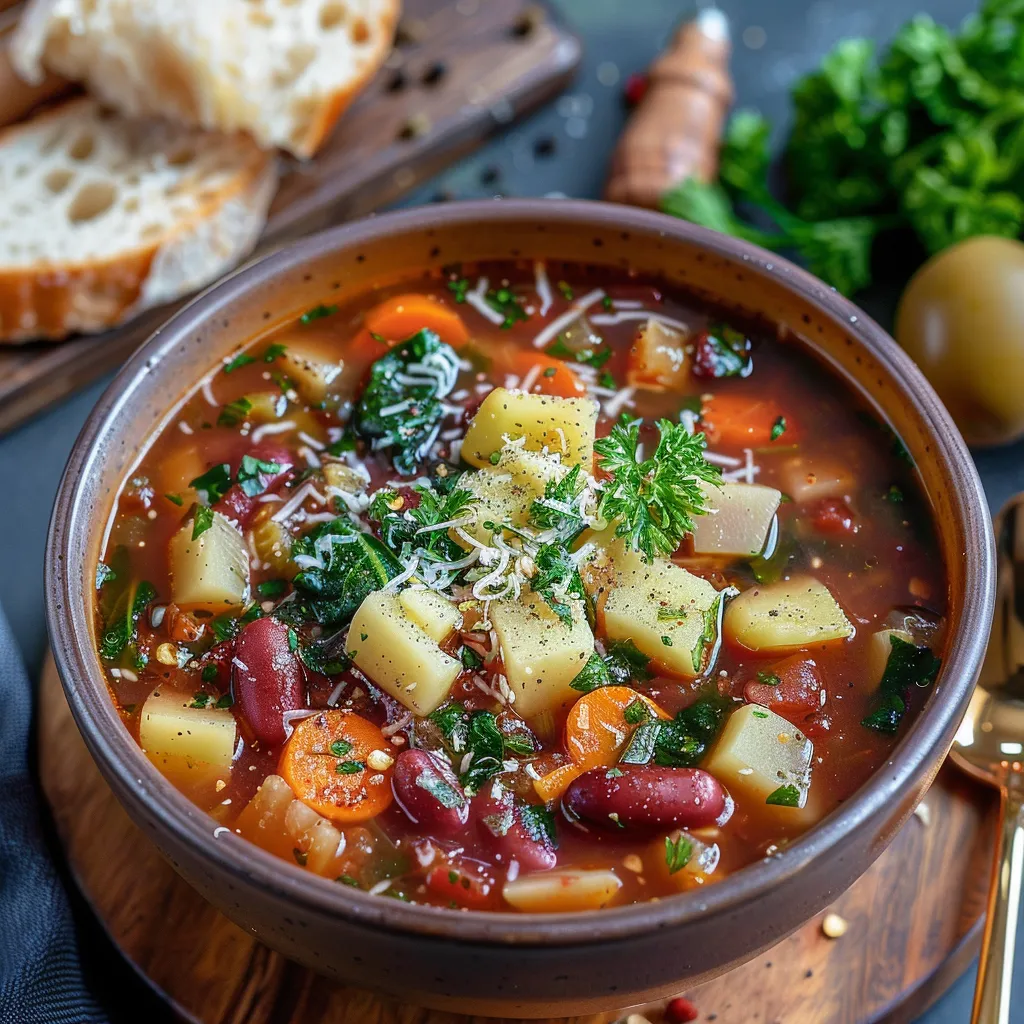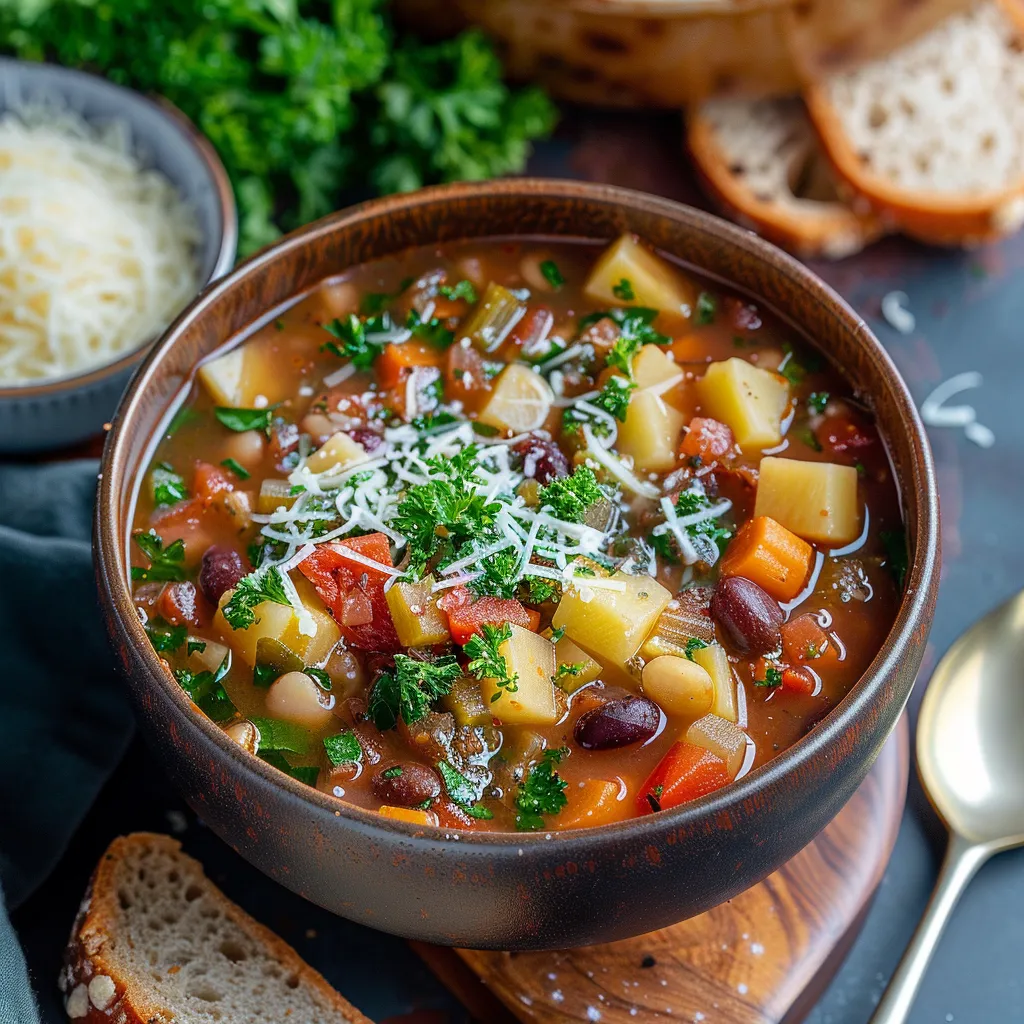 Pin it
Pin it
This hearty Olive Garden Minestrone Soup copycat recipe brings the beloved restaurant classic straight to your home kitchen. Brimming with fresh vegetables, beans, pasta, and aromatic herbs, it delivers that familiar comforting taste while allowing you to control the ingredients and freshness.
I first made this soup during a particularly cold winter when my family was craving something warm and hearty but didn't want to venture out to a restaurant. Now it's become our Sunday afternoon tradition whenever the temperature drops below 50 degrees.
Ingredients
- Olive or avocado oil: Creates the perfect base for sautéing vegetables without overpowering other flavors
- Onion, celery, and carrots: Form the classic mirepoix that builds deep flavor foundation
- Garlic: Adds aromatic punch that makes this soup taste authentically Italian
- Vegetable broth: Provides rich savory taste while keeping the recipe vegetarian
- Fire-roasted tomatoes: Offer smokiness and depth that regular canned tomatoes lack
- Tomato paste: Concentrates the umami flavor and thickens the broth slightly
- Italian seasoning, oregano, and parsley: Create that signature Olive Garden herb profile
- Sugar: Balances acidity from the tomatoes for perfect flavor harmony
- Salt and pepper: Enhance all other ingredients without making the soup too salty
- Red pepper flakes: Add pleasant warmth without overwhelming heat
- Zucchini or squash: Provide tender texture and mild flavor that absorbs the broth beautifully
- Cannellini and kidney beans: Deliver hearty protein and create satisfying texture contrast
- Ditalini pasta: Gives authentic Italian appeal and absorbs flavors while cooking
- Frozen green beans: Maintain their texture better than canned versions
- Fresh spinach: Adds vibrant color and nutritional boost at the final stage
Step-by-Step Instructions
- Sauté the Aromatics:
- Heat oil in a large Dutch oven over medium heat. Add onions, celery, and carrots, cooking for 2-3 minutes until translucent. This process releases their natural sweetness and creates the flavor foundation for your soup. Add garlic during the last 30 seconds to prevent burning while still releasing its essential oils.
- Build the Broth Base:
- Pour in vegetable broth and add tomatoes, tomato paste, and all seasonings. This combination creates that signature savory Olive Garden flavor profile with balanced acidity and warmth. Increase heat to high and bring to a full boil to help the flavors begin to meld together.
- Add Vegetables and Beans:
- Once boiling, add zucchini and both types of beans. Return to a boil before adding pasta and frozen green beans. The timing here is crucial as it ensures the squash becomes tender without overcooking, while beans maintain their shape. Reduce to medium-high heat and boil 7-8 minutes until pasta reaches perfect al dente texture.
- Finish with Greens:
- Stir in chopped spinach and immediately turn off heat. The residual warmth wilts the spinach without making it mushy or losing its vibrant color. Let soup rest for a few minutes before serving to allow flavors to fully develop and meld together.
 Pin it
Pin it
The fire-roasted tomatoes are truly my secret weapon in this recipe. I discovered their power accidentally when I grabbed the wrong can at the grocery store one day. The subtle smokiness they add transforms this from a good minestrone to an extraordinary one that has guests asking for my special ingredient.
Making Ahead and Storage Tips
This minestrone soup ages like fine wine in your refrigerator. The flavors deepen and meld overnight, making it perhaps even more delicious the next day. For best results, store cooled soup in airtight containers in the refrigerator for up to 5 days. When freezing, I recommend doing so without the pasta if possible, as it tends to absorb too much liquid and become mushy upon thawing. Simply cook fresh pasta separately when reheating frozen portions.
Smart Substitutions
The beauty of minestrone lies in its flexibility. No zucchini? Yellow squash or even diced sweet potatoes work wonderfully. Short on spinach? Try kale or Swiss chard, though they'll need an extra minute of cooking time. For a gluten-free version, simply substitute rice, quinoa pasta, or even a handful of cooked rice for the ditalini. If you're not vegetarian, chicken broth provides a different but equally delicious flavor profile.
Serving Suggestions
Transform this soup from side dish to showstopper by serving it with crusty garlic bread or homemade focaccia for dipping. A sprinkle of freshly grated Parmesan or nutritional yeast adds wonderful umami complexity. For a complete meal, pair with a simple Italian salad dressed with olive oil and balsamic vinegar. During summer months, I sometimes serve this soup at room temperature with a dollop of pesto on top for a refreshing twist.
 Pin it
Pin it
Enjoy this hearty soup with family and friends, perfect for any season but especially comforting during chilly nights.
Frequently Asked Questions
- → Can I make this minestrone soup in advance?
Yes! This soup actually tastes better the next day as the flavors have time to meld. Store it in an airtight container in the refrigerator for 4-5 days. For longer storage, freeze portions for up to 4-5 months.
- → What can I substitute for ditalini pasta?
Elbow macaroni works perfectly as mentioned in the recipe notes. Other small pasta shapes like small shells, orzo, or even broken spaghetti pieces can work well too.
- → Is this minestrone soup vegetarian?
Yes, this soup is vegetarian as written, using vegetable broth as the base. It's packed with plant-based protein from the cannellini and kidney beans.
- → Can I make this soup in a slow cooker?
Absolutely! Sauté the onions, celery, carrots and garlic first, then transfer to a slow cooker with remaining ingredients except pasta and spinach. Cook on low for 6-8 hours, add pasta for the last 30 minutes, and stir in spinach just before serving.
- → How can I make this minestrone soup more hearty?
To make it more substantial, you can add more beans or pasta, include additional vegetables like potatoes or bell peppers, or even add some cooked Italian sausage if you don't need it to be vegetarian.
- → Why shouldn't I add the spinach too early?
Adding spinach too early will cause it to overcook and become mushy. For the best texture and bright green color, add the spinach at the very end and let the residual heat wilt it naturally.
